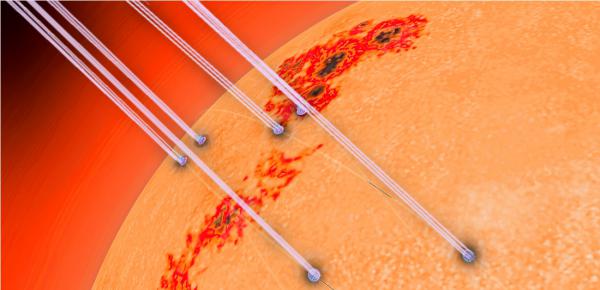BY LETTER
New Brooklyn Beamrider Arrays
Technology > Application > Construction
Technology > Application > Transportation > Interstellar Transport
Technology > Application > Megascale Engineering
Technology > Application > Transportation > Interstellar Transport
Technology > Application > Megascale Engineering
Beam emitters set directly into the surface of the cool star Little Brooklyn | |
 Image from Steve Bowers | |
| The emitters extract energy from deep inside the star, and operate at a higher temperature than the surface of this cool red dwarf | |
The Inner Sphere star system New Brooklyn began its role as a transport hub during the First Federation with its abundant helium-3 and construction of beamrider arrays. Except for deactivating its beamrider arrays (and wormholes) during interstellar wars, New Brooklyn has continuously operated beamrider stations for over 9,000 years. This long operation has resulted in a problem.
The problem was a physical principle summarized by the Old Earth human Isaac Newton: "For every action, there is an equal and opposite reaction."
While beamrider ships flew far and fast because of that the bodies that mounted beamrider arrays gradually had their orbits altered by the equal-and-opposite thrust of their arrays, which were effectively very high exhaust velocity rocket engines. It complicated beam aiming over interstellar distances and, for lighter moons or space stations, eventually threatened to de-orbit the array.
In New Brooklyn, beamrider array operators became frustrated with the enormous effort needed to restore orbits. For example, if it was desired to counteract 100 years of beam output from a moon in one year, then one hundred times the thrust of the array was required. That required a significant consumption of mass and energy. The engines - conversion or reactionless - that could counteract a moon's drift were better applied propelling starships. The Brooklynite solution was simple in principle, but required some robust engineering: they would mount their beamrider arrays on a star.
The New Brooklyn system was a distant binary consisting of a K5V star ("New Brooklyn") and an M3V ("Little Brooklyn"). As an M3V star, Little Brooklyn is a small, dense object scarcely larger than gas giants or brown dwarfs, but much more massive. With some advanced materials and robust engineering, it was possible to float beamrider stations on the "surface" (such as it was) of the red dwarf.
There was no innovation to putting a complicated magmatter system in a star. Indeed, New Brooklyn had carefully studied others' breakthroughs; consulted with ancient sunminer clades for their genius in operating in stars; and finally designed a sturdy, reliable beamrider station. Each station was thus a typical New Brooklyn product: a solid workhorse, but not individually innovative.
But stodgy New Brooklyn mildly surprised terragen space by utilizing those small beamrider emitters in a novel fashion. Individually, they were inadequate to propel a typical beamrider ship. Grouped together, they could. And they could be grouped together in many different ways and aimed in many directions. This not only compensated for the movement of emitters across the non-solid, rotating surface of Little Brooklyn and allowed the formation of stable beams for permanent beamrider routes, it also allowed improvised generation of beams for short-term routes and to provide one-time boost or braking services to starships. Effectively, it was a phased mass array the size of a star.
The defensive possibilities were interesting, too, since an approaching relativistic fleet might suddenly find a 0.9c "hot beam" filling its approach. With a near-unlimited mass reserve, such a beam could readily overwhelm relativistic debris measures.
Because the "Brooklyn Beamrider Array" required a dense, massive object like a higher mass brown dwarf or lower mass red dwarf, it has not been duplicated across the entirety of the Beamrider Network. It is, however, popular at major beamrider hub stars, which tend to meet the requirements.
Related Articles
Appears in Topics
Development Notes
Text by Mike Miller
Initially published on 16 April 2015.
Initially published on 16 April 2015.






